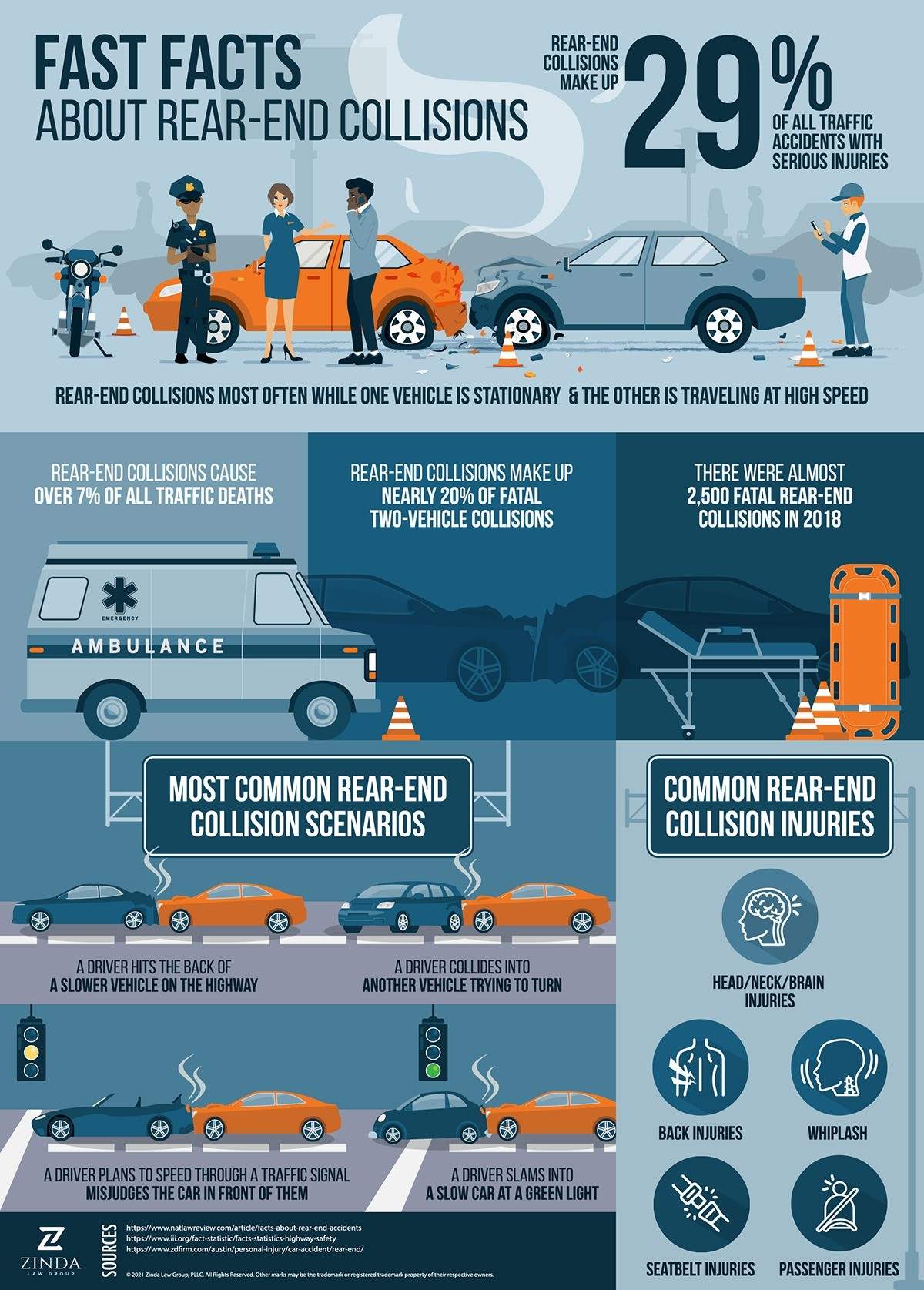CALL (800) 863-5312 TO SPEAK WITH ZINDA LAW GROUP Injury lawyers in lubbock, texas
Rear-end collisions, often referred to as “fender-benders,” occur frequently. Drivers who have been rear-ended may suffer a range of injuries which can result in steep medical costs and missed time from work. Compensation for such costs may be sought by filing an insurance claim or, if necessary, filing a lawsuit against the proper parties.
If you have been rear-ended in Lubbock, Texas, and would like to learn more about filing a claim, call Zinda Law Group at (800) 863-5312 to receive a free case evaluation with one of our friendly and experienced personal injury lawyers today.

Zinda Law Group Rear-End Collision Lawyers
COMMON CAUSES OF REAR-END ACCIDENTS
The causes of rear-end collisions are fairly common and predictable. Understanding the common causes of rear-end accidents may help prevent one from occurring. Listed below are some of the leading causes of rear-end collisions.
Tailgating
Tailgating involves one vehicle driving too closely to another vehicle. When this happens, the chances of a rear-end accident occurring increases. To prevent rear-end accidents or reduce the likelihood of them occurring, be sure to leave plenty of space between the front of your car and the bumper of the car in front of you. A good rule of thumb to follow is to leave one car-length of space between you and the other car for every 10 miles per hour you are traveling (e.g., two car lengths if traveling at 20 miles per hour; five car lengths if traveling at 50 miles per hour; etc.).
Distracted Driving
Texting, making phone calls, eating, rubber-necking, and other activities which cause a driver to take his or her eyes off the road constitute distracted driving. These activities are highly discouraged and put other motorists at risk. In order to prevent rear-end collisions due to distracted driving, be sure to maintain focus on the road at all times. These other activities can wait.
Weather
Wet, slick roads as a result of precipitation can also be a cause of rear-end collisions. These hazardous conditions can prevent a driver from decelerating or stopping their car in enough time to prevent a rear-end collision. In these situations, be sure to pay extra attention to the road, and give yourself plenty of space and time to decelerate your vehicle.
Speeding
Driving at too high of a rate of speed gives drivers less time to react to the actions of other motorists. To reduce the risk of being involved in a rear-end collision due to speeding, always be cognizant of speed limits and abide by such.
Mechanical Failure
Even the safest and most defensive drivers can end up in a rear-end collision if there is a problem with the automobile. In other words, mechanical failures with the vehicle itself can cause a rear-end collision. For example, defective brakes may result in one car crashing into another. To prevent these types of accidents, be sure to follow a proper maintenance schedule by getting your vehicle inspected when it is time to do so.
For a free legal consultation with a rear end collision lawyer serving Lubbock, call 800-863-5312
Common read-end collision injuries
Rear-end collisions are notorious for causing one or several types of injuries. Listed below are several common injuries that may result from a rear-end collision.
Back Injuries
Back injuries are one of the most common and prevalent class of injuries following a rear-end collision. Symptoms of back injuries include muscle aches, shooting or stabbing pain, loss of range of motion, and pain that radiates down to your legs. Although back pain may be mitigated with muscle relaxants and pain relievers, serious back injuries may require a visit to the emergency room or to a chiropractor.
Typically, more forceful collisions, such as those that occur at high speeds, result in a more severe injury. However, it is important to realize that even slow speed rear-end accidents can cause back injuries. It is also critical to remember that back pain may lay dormant for a period of time following a rear-end accident. In other words, it may take hours or even days after an accident for pain symptoms to take effect.
Head/Neck/Brain Injuries
Whiplash, which involves the sudden jerking of the head and neck, is perhaps the kind of injury most complained about following a rear-end collision. When a vehicle is struck from behind, the momentum of the cars forces the passengers of the front car to rapidly jerk back and forth. Common signs and symptoms of whiplash include headaches, loss of range of motion, and neck pain or stiffness.
Aside from whiplash, rear-end collisions can also lead to other forms of head, neck, and brain injuries. For example, the sudden impact between cars may cause the driver of the front car to bang his or head against the interior of the vehicle. Common symptoms of brain injuries include loss of consciousness, dizziness, confusion fatigue, and impaired speech, amongst others.
Seatbelt Injuries
Seatbelts are a surprising yet common source of rear-end collision injuries. When a car is struck from behind, a mechanism in the seatbelt causes the belt to tighten around the driver’s body. Although this mechanism is intended to keep a driver’s body in place, it can also lead to injury in the form of rashes, cuts, and lacerations.
Rear End Collision in Lubbock lawyers near me 800-863-5312
WHAT TO DO AFTER BEING INJURED IN A CAR ACCIDENT
The steps taken by a car accident victim in the hours, weeks, and months following an accident can shape the outcome of the victim’s recovery and legal remedies. Here are several important steps a rear-end accident victim should take following an accident.
1. Seek Medical Attention
Many Lubbock fender-benders result in some form of injury, particularly to the spine or neck. If you are experiencing pain following an accident, it is important that you seek professional medical attention as quickly as possible.
2. Report the Accident
Another important step to take following a rear-end accident is to report the accident to local law enforcement. Under Texas law, it is actually required that law enforcement be contacted if someone is injured in a car crash or if there is substantial damage to the vehicles.
In addition to allowing officers to assist your roadway needs, reporting the accident to law enforcement will create an official record of the automobile collision, a record which may later be used as evidence to support or corroborate your claim. You may also help your case while filling out the report by providing as much information to the reporting officer as possible, including the date, time, and location of the accident, the circumstances giving rise to the collision, and the injuries and vehicular damage sustained as a result of the crash.
3. Document the Accident
Documenting the accident is an important yet often overlooked step in the post-accident process. If executed thoroughly and meticulously, this step may help a rear-end accident victim not only keep track of all important events surrounding the accident but also substantiate any claim the victim may have.
In order to “document the accident,” the rear-end accident victim must create and maintain an organized record of all documents, files, and evidence concerning the accident. These materials may be kept as hard copies at your home or office or, alternatively, may be kept digitally on your personal electronic device.
Documents which should be kept throughout the entirety of the post-accident process include:
- Medical records
- Property repair estimates
- Witness statements
- Police reports
- Photographs of your injuries
- Photographs of the scene of the accident
- Correspondence with insurance companies
- Correspondence with the at-fault driver
4. Contact a Lubbock, Texas, Personal Injury Lawyer
Before agreeing to any settlement or speaking with insurance companies, contact a rear-end accident attorney in Lubbock, Texas. As part of an initial consultation, the attorney may ask important questions such as where the accident occurred, how it occurred, and what injuries you sustained. Based on your responses, the attorney may be able to provide valuable legal advice regarding rights and remedies available to you. An attorney may also act on your behalf by negotiating with insurance companies to establish your claim’s actual worth. If necessary, an attorney may also file a lawsuit against all necessary parties.
Click to contact our Texas Rear End Collision Car Accident Lawyer today
REAR-END ACCIDENT COMPENSATION
A rear-end accident victim who sues and prevails on a claim against the at-fault party may be entitled to monetary damages for costs incurred as a result of the accident. These damages can be segregated into two classes: economic damages and non-economic damages.
Economic damages are objective costs incurred by a rear-end accident victim. In other words, these costs or expenses can be theoretically quantified. In a rear-end accident case, economic damages may include:
- Medical expenses (e.g., doctor’s appointments)
- Prescription drug expenses
- Rehabilitation services
- Lost income and wages
- Property damage
On the other hand, non-economic damages reflect the subjective, intangible costs incurred by a rear-end accident victim. In contrast to economic damages, non-economic damages cannot be easily calculated following an accident. Instead, non-economic damages are subjectively evaluated by a jury in a lawsuit. Types of non-economic damages in a rear-end accident case may include:
- Pain and suffering
- Emotional distress
- Disability
- Loss of consortium
- Loss of enjoyment of life
Complete a Free Case Evaluation form now
STATUTE OF LIMITATIONS for a REAR-END car accident claim
All states have legal time limits, formally referred to as a “statute of limitations,” within which an injured party must file a lawsuit. If a party forgets, neglects, or otherwise fails to file a lawsuit within the applicable statute of limitations, that party may be deemed to have forfeited some or all legal rights and may further be barred from filing a claim entirely.
Statutes of limitations vary from state to state. Texas has a two-year statute of limitations for personal injury claims, including claims arising from a rear-end accident. This means that a rear-end car accident victim wishing to file a lawsuit in Texas must do so within two years of the date of the injury. Thus, for instance, if you were injured in a rear-end car collision on January 1, 2021, you would have until January 1, 2023, to file a lawsuit.
In narrow, limited circumstances, the statute of limitations may be extended or “tolled” beyond the original two-year period. For example, when a child is the injured party in a rear-end accident, the statute of limitations will be tolled until two years after the child reaches the age of majority.
Let a zinda law group REAR-END ACCIDENT LAWYER fight for you
At Zinda Law Group, our team of rear-end accident attorneys has the experience and resources necessary to handle your claim from beginning to end. While you focus on recovering from your injuries, we are eager to investigate your claim, create a legal strategy, and handle insurance companies.
Our firm also believes that an injury victim should never have to worry about being able to afford excellent legal representation. That is why we offer 100% free consultations, and why you pay nothing unless we win your case. That’s our No Win, No Fee Guarantee.
To learn more about what we can do for you, call us at (800) 863-5312 to receive your free case evaluation with injury lawyers in Lubbock, Texas.
Meetings with attorneys are available by appointment only.
Call or text 800-863-5312 or complete a Free Case Evaluation form




























